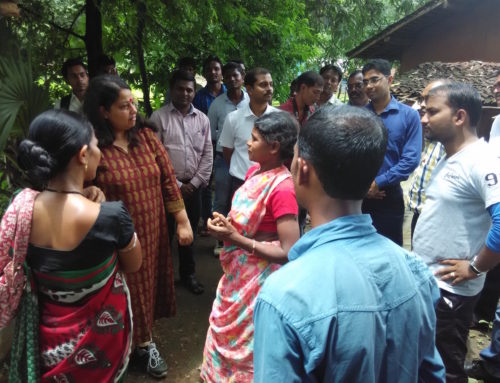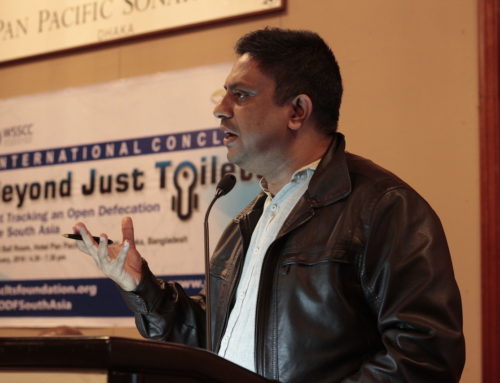Sparking a social movement on sanitation through CLTS in Nepal
In this interview with Kamal Adhikari, Department of Water Supply and Sewerage (DWSS), Government of Nepal, AmitSengupta finds out how community led total sanitation approach played a crucial role in sparking a social movement on sanitation in Nepal.
Excerpts from the interview:
CLTS Foundation: Could you please tell us, in brief, about your background and your first orientation about community led total sanitation approach?
I am from a rural community of Dang district in Nepal. I hold Master’s Degree in Anthropology and Bachelors Degree in Mathematics and Law. Since 1999, I have been working as a Sociologist with the Department of Water Supply and Sewerage(DWSS) of the Government of Nepal and contributing to formulate national polices, plans and guidelines on sanitation and hygiene including School Led Total Sanitation(SLTS) Program 2006, Sanitation and Hygiene Master Plan 2011andTotal Sanitation Guidelines 2015.I have widely served for strengthening the sector capacity, scaling up strategic planning and localization of the Master Plan.I have produced more than two dozens of research and study papers on sectoral issues, received national and international trainings and presented papers in national, regional and global forums. I became familiar with Community Led Total Sanitation (CLTS) approach widely discussed during the first SACOSAN held in Bangladesh in 2003.
CLTS Foundation: Could you briefly take us through the sanitation scenario in Nepal in the past 10 years and its status now?
Stakeholders’ perception towards sanitation changed drastically in Nepal after introduction of the community and school led total sanitation approaches. The Open Defecation Free (ODF) campaign strongly grounded the issues of health and dignity in the domain of sanitation and hygiene and created a very amiable environment to nurture and institutionalize sanitation as the cross-cutting theme of development.Now, the ODF has become a central theme in country’s national development framework.The national sanitation coverage has increased significantly from some 40 % in 2005to 81 % by 2015. So far, 1 zone, 33 districts, 83 Municipalities and 2081VDCshave been declared as ODF areas against the national target of universal sanitation coverage by 2017. ODF declaration has been evolving as the socio-cultural festival in local communities. The country is marching ahead for total sanitation initiativeso as to sustain the ODF status and achieve the state of Clean Nepal.
CLTS Foundation: You have been applying the fundamental spirit of triggering–the heart of the CLTS approach–in formulating and executing the School Led Total Sanitation (SLTS) approach, Sanitation and Hygiene Master Plan 2011 and Total Sanitation Guidelines 2015 of the Government of Nepal. Could you elaborate on this please?
It is crystal clear thatinnovative triggering process introduced through the CLTS approach has brought about revolutionary changes in thinking and action in sanitation across the globe. The DWSS and UNICEF Nepal introduced the innovative concept of SLTS program approach in Nepalby including the ‘principle of CLTS triggering’ and multi-sector stakeholders’ collaboration mechanism institutionalized by the School Sanitation and Hygiene Program 2000. The SLTS approach widely popularized appreciative techniques like reward and recognition, strengthened school and community partnership and catalyzed students to work as the change agent for achieving ODF status in school’s catchments. The Government of Nepal formulated the Master Plan on Sanitation and Hygiene in 2011 adopting triggering approach of CLTS, institutionalizing multi-stakeholders’ collaboration promoted through SLTS and integrating other innovative sectoral learning. Likewise, the Total Sanitation Guideline has widen the scope of sanitation leading to sustained environment, improved health condition, better livelihood and productive life.
CLTS Foundation: How and when did you introduce the philosophy, principles, themes and frameworks of the ‘sector triggering’ based on good learning from CLTS and SLTS approaches?
Nepal’s capacity development model in sanitation changed remarkably from ‘knowledge building enterprises’ to ‘triggering’ through CLTS and SLTS approaches. The concept of CLTS triggeringwhich focuses mainly on ‘triggering of communities’ got new dimension in Nepal along with enforcement of the Sanitation and Hygiene Master Plan 2011. Based on learning from CLTS, SLTS, SULABH Sanitation Movement and Comprehensive and Accelerated Sanitation and Hygiene Sanitation initiative of Nepal, I introduced in 2010 the philosophy, principles, themes and frameworks of ‘sector triggering’approach (triggering of different development sector stakeholders)that gives due focus on broad based alliance, wider sectoral linkages, comprehensive planning, effective community mobilization, massive resource pooling arrangements and wider political mobilization for the scaling up of sanitation in an accelerated manner.Sector triggering approach is adoptednationwide.I have widely applied this approach while orienting law-makers, senior political leaders and stakeholdersabout sanitation in national and sub-national levels.
CLTS Foundation: What has been happening in sanitation sector in Nepal as far as innovations are concerned?
Nepal’s sanitation movement is characterized uniquely.Institutionalization of sanitation and hygiene as the cross-cutting theme of development, introduction of sector triggering approach, promotion of reward and recognition, scaling up of sanitation as social movement, promotion of sanitation model district initiative and emergence of ODF and total sanitation as the development ladder(e.g. declaration of indoor smoke free households, total literate communities, etc.) are some innovations. Importantly, the Sanitation and Hygiene Master Plan 2011 has became a strong instrument to generate synergy from multi-sector stakeholders’coordination mechanisms and maintain uniformity and standard in sanitation and hygiene interventionsthrough enforcement of the guiding principles. Importantly, the sanitation conferencehas strongly vibrated ‘policy makers, planners and people’, powerfully triggered ‘mass action’ and visibly ‘accelerated ODF campaign’ along with the creative engagement of school and communities.Linkage of sanitation and hygiene with nutrition, education, health, environment and livelihood has given new dimension.
CLTS Foundation: What are the different actors doing to reduce open defecation involving the community?
The Master Plan on Sanitation and Hygiene 2011 has promoted government’s leadership, stakeholders’ partnership, private sector engagement and community’s ownership for sanitation and hygiene promotion. Proactive engagement of politicians, policy makers, planners, private sector actors, professionals and people in ODF and total sanitation initiatives and adoption of sanitation for all (as a dream) and all for sanitation (as a strategy) justifies that Nepal’s sanitation movement is inclusive and dynamic. Participation of the president, vice president, prime minister, law-makers, senior government officials and national artists in ODF declaration ceremony has heightened theimage of sanitation. Institutionalization of sanitation as fundamental right in the Constitution of Nepal 2015, formulation of Sanitation MDG Acceleration Framework 2013 by National Planning Commission, integration of ODF as a keybusiness in sectoral development and execution of school and community level plan of action on sanitation has unified various segments of society for improved sanitation.
CLTS Foundation: How does the process of institutional triggering happen in Nepal? Is the government of Nepal aware of the challenges and how is it overcoming the hurdles?
Of course, ‘institutional triggering’ (i.e. sector triggering) takes place in Nepal through interactive and participatory process: a) mass gathering b) performance review meetingc) planning workshop and d) national and sub-national level sanitation conferences. During such events, burning issues on sanitation and hygiene are identified, local level opportunities are assessed, roles, responsibility and accountability of various sector stakeholders are identified, target of ODF and total sanitation are set and a joint declaration is signed to achieve the target. The powerful and thought provoking triggering is done to stimulatethose wide ranges of stakeholders.
The Government of Nepal is fully committed to addressing GESI issues and ensuring national sanitation goal by minimizing external dependency and maximizing local resources and capacity. For this, the national and sub-national level steering and coordination committees have led to strengthen stakeholders’ collaborationand launch sanitation conferences for mass actionto bring visible impact in community sanitation.
CLTS Foundation: How did the CLTS approach help in creating a sanitation movement in your country?
In Nepal, community triggering has produced a small spark while sector triggering has refueled so many sparksacross the country and illuminated the wider areas through multi stakeholders’ collaboration. So, these two powerful currents generated from communities and sectoral levels are unified undergovernment led district, municipality and VDC level strategic planning frameworks to accelerate ODF and total sanitation initiatives. Application of CLTS triggering tools and locally generated innovative community empowerment and sensitization tools have had profound implications in establishing pro-sanitation values and triggering local people towards breaking the route of faecal oral contamination through collective community actions. Triggering–the heart of CLTS approach–has thus played instrumental role in Nepal’s sanitation movement.
CLTS Foundation: Did you have to work on identifying Natural Leaders and CLTS Champions from the community? How was that useful in implementation of the projects?
Nepal’s ongoing sanitation movement has rapidly increased ODF and sanitation coverage and promoted several innovations. ODF and total sanitation condition have become the new norms in sanitation which have empowered and instigated several individuals to work for sanitation. For example, some teachers, women leader, students, media people, VDC secretaries, Local Development Officers and other government officials have spontaneously emerged as the sanitation champions and taken a lead to positively influence sanitation initiatives through community actions and sectoral development process. Those committed individuals are indeed the real movers and shakers of sanitation who are engaged in generating local level resources, formulating code of conducts, lending support hands for physically challenged people for toilet construction, conducting self-monitoring, telling success stories of improved sanitation and hygiene, persuading communities and propelling sanitation movement using innovative and creative ideas, methods, tools and tricks.
CLTS Foundation: You have mentioned about your book on sanitation – ‘Sanitation in Nepal: Past, Present and Future’. What is it about?
I published my book on sanitation in 2012 and its second edition in 2015 to document the precious learning of the sanitation and hygiene sector in Nepal. This book is a reflection of my subtle visualization and critical outlook on sanitation. I have captured and assessed not only physical and material but also human, sentimental and institutional aspects of sanitation and hygiene. In this book, I have located Nepal’s sanitation development in historical frame, assessed the policies, plans and programs vis-à-vis sector dynamics, dig out hidden-socio cultural issues and portrayed the changing paradigm of sanitation interventionsconsidering philosophical, methodological, governance, behavioral, socio-cultural and technological dimensions. Through this book, I haveintroduced the concept of ‘sector triggering’,’cross-border sanitation intervention’,frameworksfor behavioral change, sanitation-hydro electricity comparative model and post-2017 vision on sanitation.Both national and international level WASH sector professionals have reviewed the book and put their reflection about it.






Leave A Comment